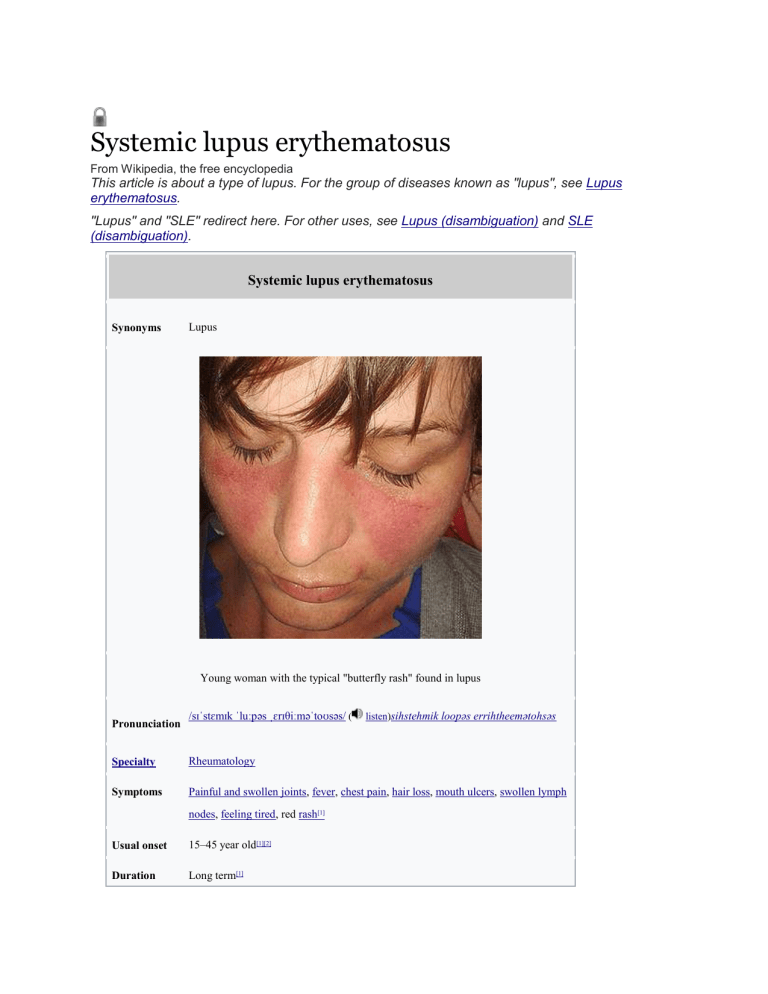Systemic lupus erythematosus
advertisement

Systemic lupus erythematosus From Wikipedia, the free encyclopedia This article is about a type of lupus. For the group of diseases known as "lupus", see Lupus erythematosus. "Lupus" and "SLE" redirect here. For other uses, see Lupus (disambiguation) and SLE (disambiguation). Systemic lupus erythematosus Lupus Synonyms Young woman with the typical "butterfly rash" found in lupus Pronunciation /sɪˈstɛmɪk ˈluːpəs ˌɛrɪθiːməˈtoʊsəs/ ( listen)sihstehmik loopəs errihtheemətohsəs Specialty Rheumatology Symptoms Painful and swollen joints, fever, chest pain, hair loss, mouth ulcers, swollen lymph nodes, feeling tired, red rash[1] Usual onset 15–45 year old[1][2] Duration Long term[1] Causes Unclear[1] Diagnostic Based on symptoms and blood tests[1] method Medication NSAIDs, corticosteroids, immunosuppressants, hydroxychloroquine, methotrexate[1] Prognosis 15 year survival ~80%[3] Frequency 2–7 per 10,000[2] [edit on Wikidata] Systemic lupus erythematosus (SLE), also known simply as lupus, is an autoimmune disease in which the body's immune system mistakenly attacks healthy tissue in many parts of the body.[1] Symptoms vary between people and may be mild to severe.[1] Common symptoms include painful and swollen joints, fever, chest pain, hair loss, mouth ulcers, swollen lymph nodes, feeling tired, and a red rash which is most commonly on the face.[1] Often there are periods of illness, called flares, and periods of remission during which there are few symptoms.[1] The cause of SLE is not clear.[1] It is thought to involve genetics together with environmental factors.[4] Among identical twins, if one is affected there is a 24% chance the other one will be as well.[1] Female sex hormones, sunlight, smoking, vitamin D deficiency, and certain infections, are also believed to increase the risk.[4] The mechanism involves an immune response by autoantibodies against a person's own tissues.[1] These are most commonly anti-nuclear antibodies and they result in inflammation.[1] Diagnosis can be difficult and is based on a combination of symptoms and laboratory tests.[1]There are a number of other kinds of lupus erythematosus including discoid lupus erythematosus, neonatal lupus, and subacute cutaneous lupus erythematosus.[1] There is no cure for SLE.[1] Treatments may include NSAIDs, corticosteroids, immunosuppressants, hydroxychloroquine, and methotrexate.[1]Alternative medicine has not been shown to affect the disease.[1] Life expectancy is lower among people with SLE.[5] SLE significantly increases the risk of cardiovascular disease with this being the most common cause of death.[4] With modern treatment about 80% of those affected survive more than 15 years.[3] Women with lupus have pregnancies that are higher risk but are mostly successful.[1] Rate of SLE varies between countries from 20 to 70 per 100,000.[2] Women of childbearing age are affected about nine times more often than men.[4]While it most commonly begins between the ages of 15 and 45, a wide range of ages can be affected.[1][2] Those of African, Caribbean, and Chinesedescent are at higher risk than white people.[4][2] Rates of disease in the developing world are unclear.[6] Lupus is Latin for "wolf": the disease was so-named in the 13th century as the rash was thought to appear like a wolf's bite.[7] Video explanation Contents [hide] 1Signs and symptoms o 1.1Skin o 1.2Muscles and bones o 1.3Blood o 1.4Heart o 1.5Lungs o 1.6Kidneys o 1.7Neuropsychiatric o 1.8Reproductive o 1.9Systemic 2Causes o 2.1Genetics o 2.2Drug reactions o 2.3Non-systemic forms of lupus 3Pathophysiology o 3.1Cell death signaling o 3.2Clearance deficiency o 3.3Germinal centers o 3.4Anti-nRNP autoimmunity o 3.5Others 4Diagnosis o 4.1Laboratory tests o 4.2Diagnostic criteria 5Treatment o 5.1Medications o 5.2Lifestyle changes o 5.3Kidney transplantation o 5.4Antiphospholipid syndrome o 5.5Management of pregnancy 6Prognosis 7Epidemiology o 7.1Ethnicity o 7.2Sex o 7.3Changing rate of disease 8History o 8.1Etymology o 8.2Classical period o 8.3Neoclassical period o 8.4Modern period 9Research 10See also 11References 12External links Signs and symptoms Common symptoms of SLE.[8] SLE is one of several diseases known as "the great imitator" because it often mimics or is mistaken for other illnesses.[9] SLE is a classical item in differential diagnosis,[10] because SLE symptoms vary widely and come and go unpredictably. Diagnosis can thus be elusive, with some people having unexplained symptoms of SLE for years. Common initial and chronic complaints include fever, malaise, joint pains, muscle pains, and fatigue. Because these symptoms are so often seen in association with other diseases, these signs and symptoms are not part of the diagnostic criteria for SLE. When occurring in conjunction with other signs and symptoms (see below), however, they are considered suggestive.[11] While SLE can occur in both males and females, it is found far more often in women, and the symptoms associated with each sex are different.[5] Females tend to have a greater number of relapses, a low white blood cell count, more arthritis, Raynaud's phenomenon, and psychiatric symptoms. Males tend to have more seizures, kidney disease, serositis (inflammation of tissues lining the lungs and heart), skin problems, and peripheral neuropathy.[12] Skin As many as 70% of people with lupus have some skin symptoms. The three main categories of lesions are chronic cutaneous (discoid) lupus, subacute cutaneous lupus, and acute cutaneous lupus. People with discoid lupus may exhibit thick, red scaly patches on the skin. Similarly, subacute cutaneous lupus manifests as red, scaly patches of skin but with distinct edges. Acute cutaneous lupus manifests as a rash. Some have the classic malar rash (or butterfly rash) associated with the disease.[13] This rash occurs in 30 to 60% of people with SLE.[14] Hair loss, mouth and nasal ulcers, and lesions on the skin are other possible manifestations.[15] Muscles and bones The most commonly sought medical attention is for joint pain, with the small joints of the hand and wrist usually affected, although all joints are at risk. More than 90 percent of those affected will experience joint and/or muscle pain at some time during the course of their illness.[16] Unlike rheumatoid arthritis, lupus arthritis is less disabling and usually does not cause severe destruction of the joints. Fewer than ten percent of people with lupus arthritis will develop deformities of the hands and feet.[16] People with SLE are at particular risk of developing osteoarticular tuberculosis.[17] A possible association between rheumatoid arthritis and SLE has been suggested,[18] and SLE may be associated with an increased risk of bone fractures in relatively young women.[19] Blood Anemia is common in children with SLE[20] and develops in about 50% of cases.[21] Low platelet and white blood cell counts may be due to the disease or a side effect of pharmacological treatment. People with SLE may have an association with antiphospholipid antibody syndrome[22] (a thrombotic disorder), wherein autoantibodies to phospholipids are present in their serum. Abnormalities associated with antiphospholipid antibody syndrome include a paradoxical prolonged partial thromboplastin time (which usually occurs in hemorrhagic disorders) and a positive test for antiphospholipid antibodies; the combination of such findings have earned the term "lupus anticoagulant-positive". Another autoantibody finding in SLE is the anti-cardiolipin antibody, which can cause a false positive test for syphilis.[citation needed] Heart SLE may cause pericarditis - inflammation of the outer lining surrounding the heart, myocarditis inflammation of the heart muscle, and/or endocarditis - inflammation of the inner lining of the heart. The endocarditis of SLE is non-infectious, and is also called (Libman–Sacks endocarditis). It involves either the mitral valve or the tricuspid valve. Atherosclerosis also occurs more often and advances more rapidly than in the general population.[23][24] Lungs Inflammation of the pleurae known as pleurisy can rarely give rise to shrinking lung syndrome.[25] SLE can cause pleuritic pain and also give rise to shrinking lung syndrome, involving a reduced lung volume.[26] Other associated lung conditions include pneumonitis, chronic diffuse interstitial lung disease, pulmonary hypertension, pulmonary emboli, and pulmonary hemorrhage. Kidneys Painless passage of blood or protein in the urine may often be the only presenting sign of kidney involvement. Acute or chronic renal impairment may develop with lupus nephritis, leading to acute or end-stage kidney failure. Because of early recognition and management of SLE, end-stage renal failure occurs in less than 5%[27][28] of cases; except in the black population, where the risk is many times higher. The histological hallmark of SLE is membranous glomerulonephritis with "wire loop" abnormalities.[29] This finding is due to immune complex deposition along the glomerular basement membrane, leading to a typical granular appearance in immunofluorescence testing. Neuropsychiatric Further information: Neuropsychiatric systemic lupus erythematosus Neuropsychiatric syndromes can result when SLE affects the central or peripheral nervous system. The American College of Rheumatology defines 19 neuropsychiatric syndromes in systemic lupus erythematosus.[30] The diagnosis of neuropsychiatric syndromes concurrent with SLE (now termed as NPSLE),[31] is one of the most difficult challenges in medicine, because it can involve so many different patterns of symptoms, some of which may be mistaken for signs of infectious disease or stroke.[32] A common neurological disorder people with SLE have is headache,[33] although the existence of a specific lupus headache and the optimal approach to headache in SLE cases remains controversial.[34] Other common neuropsychiatric manifestations of SLE include cognitive dysfunction, mood disorder, cerebrovascular disease,[33] seizures, polyneuropathy,[33] anxiety disorder, psychosis, depression, and in some extreme cases, personality disorders.[35] Steroid psychosis can also occur as a result of treating the disease.[31] It can rarely present with intracranial hypertension syndrome, characterized by an elevated intracranial pressure, papilledema, and headache with occasional abducens nerve paresis, absence of a space-occupying lesion or ventricular enlargement, and normal cerebrospinal fluid chemical and hematological constituents.[36] More rare manifestations are acute confusional state, Guillain–Barré syndrome, aseptic meningitis, autonomic disorder, demyelinating syndrome, mononeuropathy (which might manifest as mononeuritis multiplex), movement disorder (more specifically, chorea), myasthenia gravis, myelopathy, cranial neuropathy and plexopathy. Neurological disorders contribute to a significant percentage of morbidity and mortality in people with lupus.[37] As a result, the neural side of lupus is being studied in hopes of reducing morbidity and mortality rates.[30] One aspect of this disease is severe damage to the epithelial cells of the blood– brain barrier. In certain regions, depression affects up to 60% of women with SLE.[38] Reproductive Further information: Systemic lupus erythematosus and pregnancy SLE causes an increased rate of fetal death in utero and spontaneous abortion (miscarriage). The overall live-birth rate in people with SLE has been estimated to be 72%.[39] Pregnancy outcome appears to be worse in people with SLE whose disease flares up during pregnancy.[40] Neonatal lupus is the occurrence of SLE symptoms in an infant born from a mother with SLE, most commonly presenting with a rash resembling discoid lupus erythematosus, and sometimes with systemic abnormalities such as heart block or enlargement of the liver and spleen.[41] Neonatal lupus is usually benign and self-limited.[41] Systemic Fatigue in SLE is probably multifactorial and has been related to not only disease activity or complications such as anemia or hypothyroidism, but also to pain, depression, poor sleep quality, poor physical fitness and lack of social support.[42][43] Causes SLE is presumably caused by a genetic susceptibility coupled with an environmental trigger which results in defects in the immune system. One of the factors associated with SLE is vitamin D deficiency.[44] Genetics The first mechanism may arise genetically. Research indicates SLE may have a genetic link. SLE does run in families, but no single causal gene has been identified. Instead, multiple genes appear to influence a person's chance of developing lupus when triggered by environmental factors. HLA class I, class II, and class III genes are associated with SLE, but only classes I and II contribute independently to increased risk of SLE.[45] Other genes which contain risk variants for SLE are IRF5, PTPN22, STAT4,[46] CDKN1A,[47] ITGAM, BLK,[46] TNFSF4 and BANK1.[48] Some of the susceptibility genes may be population specific.[46] While the genetics of SLE are not very well understood, there is growing evidence for the involvement of specific genes in this complex autoimmune disease. Part of the complexity of this disease is due to the effects of both environment and genetics factors that may contribute to its development.[49] Further compounding our understanding of the etiology of the disease is the involvement of several organ systems.[50] Genetic studies of the rates of disease in families supports the genetic basis of this disease with a heritability of >66%.[51] Identical (monozygotic) twins were found to share susceptibility to the disease at >35% rate compared to fraternal (dizygotic) twins and other full siblings who only showed a 2–5% concordance in shared inheritance.[51] Genome-wide association studies (GWAS) revealed regions of linkage that were found on most chromosomes.[52] These studies are useful in identifying the genes that may be responsible for complex diseases such as SLE. Candidate gene loci implicated with SLE include multiple alleles from the HLA region, Fc-gamma receptor, and complement component system.[50] However, association does not prove that a specific form of a gene is responsible for the disease, as there may be other polymorphisms in the region that have a greater association effect.[50] However, because the biological role of most genes are not completely understood, it can be difficult to attribute phenotypic traits to certain genetic polymorphisms. Since SLE is associated with so many genetic regions, it is likely an oligogenic trait, meaning that there are several genes that control susceptibility to the disease.[50] Further complicating our understanding is the association of certain linkages with various ethnic groups.[50] SLE is regarded as a prototype disease due to the significant overlap in its symptoms with other autoimmune diseases.[49] This means that it is an important area of continued research and study that is utilizing diverse techniques such as GWAS, microarrays, and murine studies.[50] Further genetic studies of multiple ethnic groups and the creation of disease models incorporating environmental influences will help to increase and refine the understanding of specific genes, linkages, as well as the mechanisms underlying the disease.[51] Drug reactions Drug-induced lupus erythematosus is a (generally) reversible condition that usually occurs in people being treated for a long-term illness. Drug-induced lupus mimics SLE. However, symptoms of druginduced lupus generally disappear once the medication that triggered the episode is stopped. More than 38 medications can cause this condition, the most common of which are procainamide, isoniazid, hydralazine, quinidine, and phenytoin.[10] Non-systemic forms of lupus Discoid (cutaneous) lupus is limited to skin symptoms and is diagnosed by biopsy of rash on the face, neck, scalp or arms. Approximately 5% of people with DLE progress to SLE.[53] Pathophysiology One manifestation of SLE is abnormalities in apoptosis, a type of programmed cell death in which aging or damaged cells are neatly disposed of as a part of normal growth or functioning. In SLE, the body's immune system produces antibodies against itself, particularly against proteins in the cell nucleus. SLE is triggered by environmental factors that are unknown. The immune system must balance between being sensitive enough to protect against infection, and become sensitized to attack the body's own proteins (autoimmunity). During an immune reaction to a foreign stimulus, such as bacteria, virus, or allergen, immune cells that would normally be deactivated due to their affinity for self-tissues can be abnormally activated by signaling sequences of antigen-presenting cells. Thus triggers may include viruses, bacteria, allergens (IgE and other hypersensitivity), and can be aggravated by environmental stimulants such as ultraviolet light and certain drug reactions. These stimuli begin a reaction that leads to destruction of other cells in the body and exposure of their DNA, histones, and other proteins, particularly parts of the cell nucleus. The body's sensitized B-lymphocyte cells will now produce antibodies against these nuclear-related proteins. These antibodies clump into antibody-protein complexes which stick to surfaces and damage blood vessels in critical areas of the body, such as the glomeruli of the kidney; these antibody attacks are the cause of SLE. Researchers are now identifying the individual genes, the proteins they produce, and their role in the immune system. Each protein is a link on the autoimmune chain, and researchers are trying to find drugs to break each of those links.[10][54][55] SLE is a chronic inflammatory disease believed to be a type III hypersensitivity response with potential type II involvement.[56] Reticulate and stellate acral pigmentation should be considered a possible manifestation of SLE and high titers of anti-cardiolipin antibodies, or a consequence of therapy.[57] People with SLE have intense polyclonal B-cell activation, with a population shift towards immature B cells. Memory B cells with increased CD27+/IgD—are less susceptible to immunosuppression. CD27-/IgD- memory B cells are associated with increased disease activity and renal lupus. T cells, which regulate B-cell responses and infiltrate target tissues, have defects in signaling, adhesion, costimulation, gene transcription, and alternative splicing. The cytokines B-lymphocyte stimulator (BLys), interleukin 6, interleukin 17, interleukin 18, type I interferons, and tumor necrosis factor α (TNFα) are involved in the inflammatory process and are potential therapeutic targets.[4][58][59] In the complement system low C3 levels are associated with systemic lupus erythematosus[60] Rheumatoid Athritis Rheumatoid Arthritis: Clinical Features and Pathogenetic Mechanisms Stephen M. Krane, M.D., * and Lee S. Simon, M.D. t PATHOGENESIS OF RHEUMATOID ARTHRITIS Rheumatoid arthritis (RA) is probably a heterogeneous group of disorders in which inflammation in multiple joints is a major manifestation. 91 Although many patients have systemic manifestations (thus, "rheumatoid disease"), the involvement of synovial tissues is responsible for most of the symptoms and the chronic disability. The concept that RA is heterogeneous is based on clinical, serologic, and genetic considerations. Thirty years ago Short and colleagues1J(j still looked upon the clinical problem essentially as one disease with many manifestations. This view was based on the similarities of the joint manifestations as well as the histopathology among what would now be considered different diseases (for example, the arthritis of psoriasis or even the peripheral joint involvement of patients with ankylosing spondylitis). There are now many compelling arguments to emphasize the differences in clinical manifestations among patients with chronic polyarthritis, using the clinically apparent variations as well as genetic and serologic criteria. As far as the latter are concerned, whether a positive test for rheumatoid factor (RF) is obtained (which would serve as a basis for distinguishing one group of patients from another) would depend on the type and sensitivity of the testing procedure. Most of the clinical assays measure IgM rather than IgG RFs; the latter have been considered to be the most important in pathogenesis. Only 70% to 80% of patients will have measurable RF at some time during the disease, and a fall in the titer may 'Professor, Department of Medicine, Harvard Medical School; and Chief of the Medical Services (Arthritis Unit), Massachusetts General Hospital, Boston, Massachusetts tlnstructor, Department of Medicine, Harvard Medical School; Clinical Associate, the Medical Services (Arthritis Unit), Massachusetts General Hospital; and Senior Staff, Department of Medicine, New England Deaconess Hospital, Boston, Massachusetts Original work described was supported by USPHS grants AM-03564 and AM-07258, and a Clinical Research Center Grant from the Arthritis Foundation. Medical Clinics of North America-Vo!' 70, ]'\0. 2, March 1986



